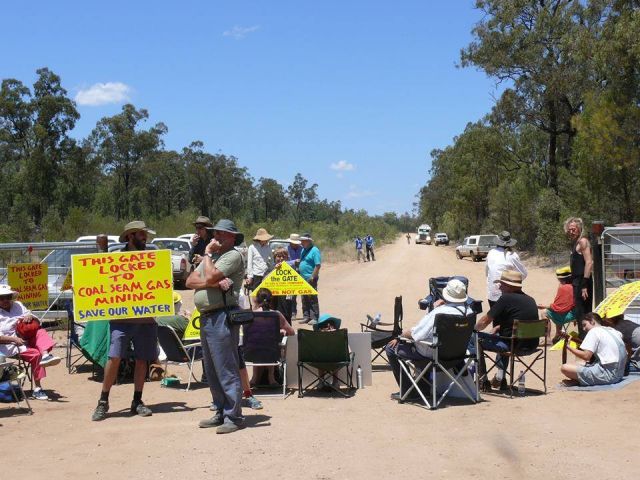
Gas giant Santos’s Environmental Impact Statement (EIS) for its proposal to create a gasfield in the Pilliga Forest was made public on February 21, two weeks after it was lodged with the government for assessment. It will be on public exhibition until just April 24.
The EIS shows that Santos still intends to drill coal seam gas (CSG) production wells despite widespread protests over the trouble-plagued Narrabri Gas Project.
The project involves the development of a CSG field of up to 850 gas wells, 425 well pads over 20 years and the construction and operation of gas processing and water treatment facilities. The additional facilities include a central gas processing facility for the compression, dehydration and treatment of gas; a water management facility for the storage and treatment of produced water; an in-field gas compression and water management facility; and water and gas gathering pipelines and ancillary infrastructure.
The NSW government has approval rights over mining applications, but the federal government also needs to give approval where threatened species are involved under the Environment Protection and Biodiversity Conservation Act. This act also contains the so-called water trigger, which allows an independent expert scientific committee to assess the impacts of proposed CSG and large coalmining developments on water resources.
In support of the project, Santos claims the project could supply up to half of NSW gas needs and provide significant benefits to the region. Supporting Santos’s claims, Australian Petroleum Production and Exploration Association CEO Malcolm Roberts said NSW currently has to import 95% of its gas supply and the east coast could face a supply shortfall as early as 2019.
But Anne Kennedy, a Coonamble farmer who has been fighting the Pilliga gas project for nine years, said: “It is ridiculous to say we are running out of gas. We are not running out of gas. It is all being exported.”
The Narrabri project has for years been the site of protests by farmers, townspeople, Traditional Owners and environmentalists. An overwhelming 96% of landholders representing 3.2 million hectares of land that Santos holds leases over have declared themselves gasfield free.
Wilderness Society Newcastle Campaign Manager Naomi Hodgson said: “Santos’s determination to push plans to drill 850 coal seam gas wells in the Pilliga Forest sets the company on a collision course with the Narrabri community and people across NSW.”
NSW Greens energy and resources spokesperson Jeremy Buckingham agreed, saying the project will “reignite the CSG wars”. He said the project posed a huge risk to land, water and the climate. The government should accept that CSG does not have a social licence to operate in NSW and reject this proposal outright.
“Drilling and potentially fracking 850 coal seam gas wells through the Great Artesian Basin is a high risk activity that will bring to the surface huge amounts of salt and chemically laden water and threaten farmland and water resources,” he said.
Santos has a tragic history of failure in the Pilliga, with at least 20 toxic waste water spills that killed large swaths of forest, including the contamination of an aquifer with uranium and other toxic heavy metals. This is from only a few gas wells in the exploration phase of this project.
Kennedy, who is also the president of the Artesian Bore Water Users Association, said if the water in the Great Artesian Basin were ruined by coal seam gas drilling, farmers would be out of business and towns would disappear.
Buckingham said: “This represents the thin edge of the wedge of a heavy industrialisation of the Pilliga Forest and agricultural land around Narrabri — 988.8 hectares of native vegetation will be removed, plus a further 181.11 hectares indirectly impacted.
“42,000 tonnes of salt per year will be generated in the initial stages of production to be dumped at an undisclosed land fill. Another 1000 tonnes per year will be irrigated onto fields or put into local waterways. Santos always promised to have a plan for their toxic waste, but it is clear they are just going to use the environment as a dump.”
The Nature Conservation Council called on the state government to buy back gas exploration licences covering the Pilliga Forest, to ensure the largest remaining temperate woodland in eastern Australia is protected for future generations.
Nature Conservation Council CEO Kate Smolski said: “This iconic forest is a refuge for koalas, eastern pygmy possums and a host of other threatened species that have disappeared from so much of NSW. The creation of an industrial gas field in this wilderness poses an unacceptable threat to native animals and critical ground water supplies.
“The project has been marred by spills and environmental breaches ever since exploration and trial drilling began. If the [Gladys] Berejiklian government approves this project, these impacts will be scaled up massively, with potentially catastrophic consequences for wildlife and water supplies.”
Communities have demonstrated their capacity to conduct sustained campaigns against unwanted CSG projects throughout the state. Santos’s Pilliga project is the next in line. As the last CSG proposal left in the state, opposition to this dangerous industry will be focused on this unnecessary scheme.
Like the article? Subscribe to Green Left now! You can also like us on Facebook and follow us on Twitter.